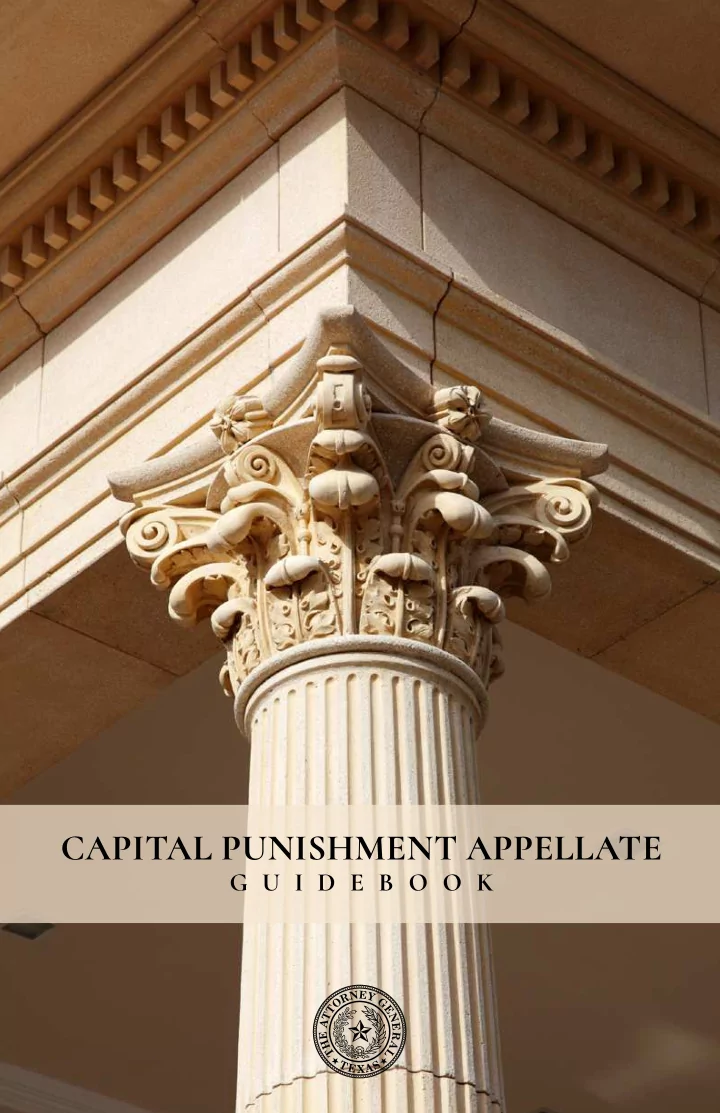

CAPITAL PUNISHMENT APPELLATE G U I D E B O O K
CAPITAL PUNISHMENT APPELLATE G U I D E B O O K CONTENTS Introduction Appellate Process ............................................................................5 Part One: Trial and Direct Appeal .........................................................................5 Trial ............................................................................................................................................... 5 Direct Appeal: Texas Court of Criminal Appeals ...........................................6 Direct Appeal: United States Supreme Court................................................. 7 Part Two: State Habeas Corpus Proceedings ................................................7 Part Three: Federal Habeas Corpus Proceedings .......................................9 The United States Court of Appeals for the Fifth Circuit ......................10 The United States Supreme Court .......................................................................10 Appellate Procedure for Capital Litigation ......................................................11 Part Four: Executive Clemency ...........................................................................12 Part Five: Execution ..................................................................................................12 Part Six: Post-Execution .........................................................................................13
INTRODUCTION APPELLATE PROCESS THE APPELLATE PROCESS AFTER A DEFENDANT IS CONVICTED OF CAPITAL MURDER AND SENTENCED TO DEATH AT TRIAL, THE APPELLATE In federal court, PROCESS BEGINS. A CAPITAL CONVICTION IS NORMALLY THE OFFICE OF THE TEXAS REVIEWED IN (APPEALED TO) BOTH STATE COURT AND FEDERAL COURT. The district attorney’s office that prosecuted the case ATTORNEY GENERAL at trial represents both the state’s and victim’s interests in state court. In federal court, the Office of the Texas Attorney General represents both the represents both the state’s and state’s and victim’s interests. The following is a brief explanation of the steps in the appellate process. The explanation assumes that the conviction and victim’s interests. death sentence are affirmed at each stage of the process. If at any given stage, either the conviction or sentence is reversed, a retrial or resentencing may be required. In any event, every case is different, and some cases may involve more appeals than others. The circumstances under which either the state or the federal courts will consider claims raised in second or successive habeas petitions (appeals) are extremely limited. PART ONE: TRIAL AND DIRECT APPEAL TRIAL A capital murder prosecution begins when the grand jury hands down an indictment charging a defendant with capital murder. The trial, which occurs in a Texas district court, proceeds in two phases. During the first phase of
the trial, called the guilt/innocence phase, the jury must decide whether DIRECT APPEAL— UNITED STATES SUPREME COURT the prosecution has proved beyond a reasonable doubt that the defendant is guilty of capital murder. If the jury finds the defendant guilty, that trial The defendant, now called the “petitioner,” files a petition for writ of certiorari proceeds to the punishment phase, during which the jury answers special in the United States Supreme Court in Washington, D.C., asking the court punishment issues. The jury’s answers to the special issues determine to review the case and arguing that the defendant’s federal constitutional whether the defendant is sentenced to death or to life imprisonment. rights were violated by the trial court or the Court of Criminal Appeals. The state continues to be represented by the district attorney at this level. The DIRECT APPEAL— state, called the “respondent,” files a brief in opposition responding to the TEXAS COURT OF CRIMINAL APPEALS petition. The state argues various reasons for the Supreme Court to decline A defendant sentenced to death is entitled to an automatic appeal to the to review the defendant’s case. In the vast majority of cases, the Supreme Texas Court of Criminal Appeals, the highest court of criminal jurisdiction in Court refuses to hear the case and denies, with a short written order, the Texas. At this point, the defendant is called the “appellant,” and the state is defendant’s petition for certiorari. At this point, the defendant’s direct appeal called the “appellee.” The record of the trial, including all documents filed is complete. in the trial court, evidence presented at trial, and the written record of the trial testimony is compiled and filed in the Court of Criminal Appeals. The PART TWO: appellant’s attorney files a brief, in which it is argued that error occurred STATE HABEAS CORPUS PROCEEDINGS during the trial and that the appellant’s conviction and/or sentence should be reversed. The district attorney’s office that prosecuted the case at trial files the state’s (appellee’s) brief responding to the claims (or grounds of A death-sentenced defendant is also entitled to seek state habeas review, error) in the appellant’s brief. In most cases, there is an oral argument before an additional appeal differing from the direct appeal in that the defendant the Court of Criminal Appeals. may raise claims based on the facts outside the trial record (for example, The Court of Criminal Appeals reviews the briefs, considers the written and ineffective assistance of trial counsel). State habeas review begins when the oral arguments advanced by each side, and issues an opinion that addresses defendant, now called the applicant, files an application for a writ of habeas each of the defendant’s claims. Based on its resolution of the claims, the corpus in the state district court in which he or she was convicted. court affirms or reverses the conviction, the sentence, or both. If the court In most cases, the Office of Capital and Forensic Writs is appointed to assist affirms the conviction and sentence, the defendant may petition the United the death-sentenced defendant in state habeas review immediately after States Supreme Court for certiorari review. Certiorari review is a discretionary the entry of judgment at trial, or at the earliest practical time, but in no event device used by the Supreme Court to choose the cases it wishes to hear. later than 30 days. In a small number of cases, other competent counsel 6 7
Recommend
More recommend